Vocal Classroom Music (Grades K–12)
Subtest 2 Sample Items
Recommendation for individuals using a screenreader: please set your punctuation settings to "most."
Expand All | Collapse All
Question 1
1. Use the example below to answer the question that follows.

Which of the following key signatures is shown in this example?
- D-flat major
- F minor
- G-flat major
- C minor
Answer to question 1
- Answer Enter to expand or collapse answer. Answer expanded
- Correct Response: A. (Objective 0008) The example presents
five flats. In every clef, the order of flats in a key signature remains the same: B-E-A-D-G-C-F. One
way to determine a "flat" key signature is to identify the second-to-last flat. The name of the second-to-last
flat is the name of the key signature, thus D-flat major.
Correct Response: A. (Objective 0008) The example presents five flats. In every
clef, the order of flats in a key signature remains the same: B-E-A-D-G-C-F. One way to determine a
"flat" key signature is to identify the second-to-last flat. The name of the second-to-last flat is
the name of the key signature, thus D-flat major.
Question 2
2. Use the excerpt below to answer the question that follows.
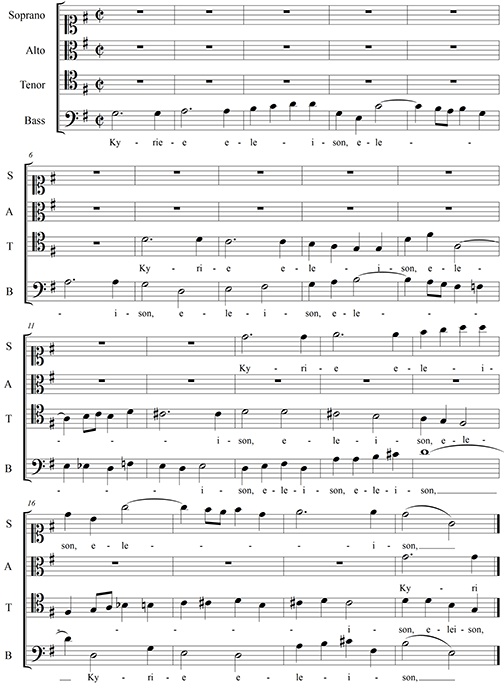
Soprano, alto, tenor, and bass. All staves are played in the key of G major with a common time signature.
All staves consist of nineteen measures.
Soprano. Measure one. Whole rest. Measure two. Whole rest. Measure three. Whole rest. Measure four.
Whole rest. Measure five. Whole rest. Measure six. Whole rest. Measure seven. Whole rest. Measure eight.
Whole rest. Measure nine. Whole rest. Measure ten. Whole rest. Measure eleven. Whole rest. Measure twelve.
Whole rest. Measure thirteen. Dotted half note on F. Quarter note on F. Measure fourteen. Dotted half
note on A. Quarter note on A. Measure fifteen. Quarter note on B. Quarter note on C. Quarter note on
D. Quarter note on D. Measure sixteen. Quarter note on F. Quarter note on D. Half note on B. Measure
seventeen. Quarter note on B. This note is connected with a tie to the half note on B in the preceding
measure. Two beamed eighth notes, A and G. Quarter note on A. Quarter note on F. Measure eighteen. Dotted
half note on A. Quarter note on A. Measure nineteen. Half note on F. Half note on B. These two half
notes are connected with a slur.
Alto. Measure one. Whole rest. Measure two. Whole rest. Measure three. Whole rest. Measure four. Whole
rest. Measure five. Whole rest. Measure six. Whole rest. Measure seven. Whole rest. Measure eight. Whole
rest. Measure nine. Whole rest. Measure ten. Whole rest. Measure eleven. Whole rest. Measure twelve.
Whole rest. Measure thirteen. Whole rest. Measure fourteen. Whole rest. Measure fifteen. Whole rest.
Measure sixteen. Whole rest. Measure seventeen. Whole rest. Measure eighteen. Dotted half note on F.
Quarter note on F.
Tenor. Measure one. Whole rest. Measure two. Whole rest. Measure three. Whole rest. Measure four. Whole
rest. Measure five. Whole rest. Measure six. Whole rest. Measure seven. Dotted half note on E. Quarter
note on E. Measure eight. Dotted half note on D. Quarter note on D. Measure nine. Quarter note on C.
Quarter note on B. Quarter note on A. Quarter note on A. Measure ten. Quarter note on E. Quarter note
on G. Half note on B. Measure eleven. Quarter note on B. This note is connected with a tie to the half
note on B in the preceding measure. Two beamed eighth notes, C and D. Quarter note on C. Quarter note
on E. Measure twelve. Dotted half note on D sharp. Quarter note on D. Measure thirteen. Half note on
E. Half note on E. Measure fourteen. Half note on D sharp. Half note on C. Measure fifteen. Quarter
note on B. Quarter note on A. Half note on G. Measure sixteen. Quarter note on G. Two beamed eighth
notes, A and B. Quarter note on C flat. Quarter note on C natural. Measure seventeen. Quarter note on
D. Quarter note on D sharp. Quarter note on E. Quarter note on C. Measure eighteen. Quarter note on
D sharp. Quarter note on E. Half note on D. Measure eighteen. Quarter note on E. Quarter note on E.
Quarter note on C. Quarter note on A.
Bass. Measure one. Dotted half note on G. Quarter note on G. Measure two. Dotted half note on A. Quarter
note on A. Measure three. Quarter note on B. Quarter note on C. Quarter note on D. Quarter note on D.
Measure four. Quarter note on G. Quarter note on E. Half note on C. Measure five. Quarter note on C.
This note is connected with a tie to the half note on C in the preceding measure. Two beamed eighth
notes, B and A. Quarter note on B. Quarter note on G. Measure six. Dotted half note on A. Quarter note
on A. Measure seven. Half note on G. Half note on D. Measure eight. Half note on E. Half note on F.
Measure nine. Quarter note on G. Quarter note on A. Half note on B. Measure ten. Quarter note on B.
This note is connected with a tie to the half note on B in the preceding measure. Two beamed eighth
notes, A and G. Quarter note on F. Quarter note on F natural. Measure eleven. Quarter note on E. Quarter
note on E flat. Quarter note on D. Quarter note on F natural. Measure twelve. Quarter note on E. Quarter
note on D. Half note on E. Measure thirteen. Quarter note on D. Quarter note on E. Quarter note on F.
Quarter note on D. Measure fourteen. Quarter note on A. Quarter note on A. Quarter note on B. Quarter
note on C sharp. Measure fifteen. Whole note on D. Measure sixteen. Quarter note on D. This note is
connected with a tie to the whole note on D in the preceding measure. Half note on D. Quarter note on
G. Measure seventeen. Half note on E. Half note on D. Measure eighteen. Quarter note on A. Quarter note
on B. Quarter note on C sharp. Quarter note on F. Measure eighteen. Half note on B. Half note on E.
These two half notes are connected with a slur.
Which of the following represents the correct pitch names for the first note in each part, listed in
order of entrance?
- G, D, F-sharp, D
- G, B, B, G
- G, A, G, D
- G, D, D, G
Answer to question 2
- Answer Enter to expand or collapse answer. Answer expanded
- Correct Response: D. (Objective 0008) The excerpt employs
three types of C clef: the soprano, alto, and tenor. The C clef is a moveable clef whose center line
designates the location of middle C. Depending on the clef's placement, middle C may be found on any
staff line, but in the excerpt it appears on the first line (soprano), the third line (alto), and the
fourth line (tenor). Once middle C is located, the rest of the pitch names on the staff can be determined
in relation to it. The bass clef indicates the location of the pitch F below middle C (the line intersecting
the two dots), from which the rest of the pitch names on the staff can be determined. With this information,
the pitch name of any note on the staves in the excerpt can be identified. In this case, the first note
of each voice, in order of entrance (bass, tenor, soprano, alto) would be G, D, D, G.
Correct Response: D. (Objective 0008) The excerpt employs three types of C clef:
the soprano, alto, and tenor. The C clef is a moveable clef whose center line designates the location
of middle C. Depending on the clef's placement, middle C may be found on any staff line, but in the
excerpt it appears on the first line (soprano), the third line (alto), and the fourth line (tenor).
Once middle C is located, the rest of the pitch names on the staff can be determined in relation to
it. The bass clef indicates the location of the pitch F below middle C (the line intersecting the two
dots), from which the rest of the pitch names on the staff can be determined. With this information,
the pitch name of any note on the staves in the excerpt can be identified. In this case, the first note
of each voice, in order of entrance (bass, tenor, soprano, alto) would be G, D, D, G.
Question 3
3. Use the example below to answer the question that follows.

The note shown in the example is equal to how many eighth notes?
- 12
- 9
- 8
- 6
Answer to question 3
- Answer Enter to expand or collapse answer. Answer expanded
- Correct Response: A. (Objective 0008) A dot attached to any
note increases its value by one-half. Since a whole note equals 8 eighth notes, the dot increases its
value by 4 more eighth notes. Therefore, the correct answer is 12.
Correct Response: A. (Objective 0008) A dot attached to any note increases its
value by one-half. Since a whole note equals 8 eighth notes, the dot increases its value by 4 more eighth
notes. Therefore, the correct answer is 12.
Question 4
4. Which of the following sets of notation symbols indicates a bowing technique for string instruments
known as ricochet?
-

Two sets of beamed sixteenth notes. Four notes in each set, all played
staccato. Tie beneath the middle two notes of the first set. Tie beneath the last note of the first
set and the first note of the second set. Tie beneath the middle two notes of the second set. Tie beneath
the last note of the second set extending to the blank space to the right.
-

-

Three beamed sixteenth notes, one isolated eighth note. All sixteenth
notes are played staccato, and there is a tie extending from the first note in this set to the last
note. Down bow mark on top of the first note in the set of beamed sixteenth notes. Up bow mark on top
of the isolated sixteenth note.
-

Answer to question 4
- Answer Enter to expand or collapse answer. Answer expanded
- Correct Response: C. (Objective 0008) The bowing technique
known as ricochet consists of throwing the bow on the string in the upper third of the bow so that it
will bounce the number of times indicated on the down-bow. Then the first note after the ricochet is
performed with an up-bow. The correct response shows the appropriate notation symbols for this technique:
the three sixteenth notes are played by dropping or throwing the bow on the string and allowing the
bow to bounce three times; then the following eighth note is played with an up-bow as indicated.
Correct Response: C. (Objective 0008) The bowing technique known as ricochet consists
of throwing the bow on the string in the upper third of the bow so that it will bounce the number of
times indicated on the down-bow. Then the first note after the ricochet is performed with an up-bow.
The correct response shows the appropriate notation symbols for this technique: the three sixteenth
notes are played by dropping or throwing the bow on the string and allowing the bow to bounce three
times; then the following eighth note is played with an up-bow as indicated.
Question 5
5. A music teacher is entering the following passage into notation software using the tuplet tool.

The quintuplet above is equivalent to which of the following rhythmic durations?
- six thirty-second notes
- four sixteenth notes
- eight sixty-fourth notes
- two eighth-note triplets
Answer to question 5
- Answer Enter to expand or collapse answer. Answer expanded
- Correct Response: B. (Objective 0008) In this example, a
sixteenth-note quintuplet is the equivalent of one beat, which equals two eighth notes or four sixteenth
notes.
Correct Response: B. (Objective 0008) In this example, a sixteenth-note quintuplet
is the equivalent of one beat, which equals two eighth notes or four sixteenth notes.
Question 6
6. Which of the following is a plagal cadence?
-
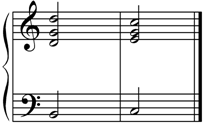
-
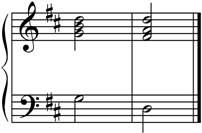
-
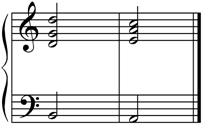
-
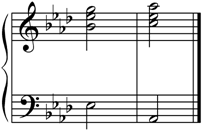
Answer to question 6
- Answer Enter to expand or collapse answer. Answer expanded
- Correct Response: B. (Objective 0009) A plagal cadence features
the chord progression IV-I. The only response option in which a subdominant chord moves to a tonic chord
is option B.
Correct Response: B. (Objective 0009) A plagal cadence features the chord progression
IV-I. The only response option in which a subdominant chord moves to a tonic chord is option B.
Question 7
7. Use the example below to answer the question that follows.

Which of the following is the correct realization for the turn illustrated in the example?
-

-

-

-

Answer to question 7
- Answer Enter to expand or collapse answer. Answer expanded
- Correct Response: C. (Objective 0009) The total value of
the realization of a turn should be exactly the same as the original note involved. Four thirty-second
notes are equal in value to one eighth note.
Correct Response: C. (Objective 0009) The total value of the realization of a turn
should be exactly the same as the original note involved. Four thirty-second notes are equal in value
to one eighth note.
Question 8
8. Use the excerpt below to answer the question that follows.
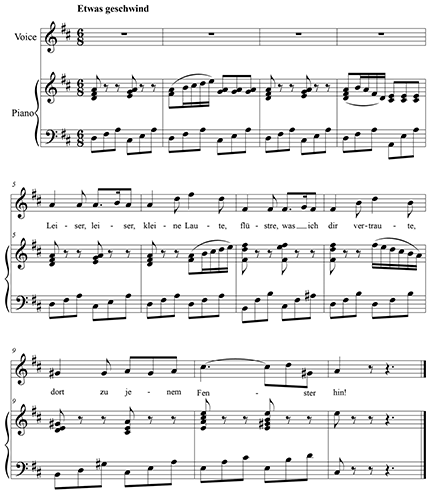
Both consist of eleven measures, and are played in D major and six over eight time signature. Voice.
First four measures only have one whole rest each. Measure five. Quarter note on A. Eighth note on A.
Three beamed notes. First is a dotted eighth note on A. Second is a sixteenth note on B. Third is an
eighth note on A. Measure six. Quarter note on A. Eighth note on D. Quarter note on F. Eighth note on
D. Measure seven. Quarter note on F. Eighth note on F. Three beamed notes. Dotted eighth note on F.
Sixteenth note on G. Eighth note on F. Measure eight. Quarter note on F. Eighth note on B. Quarter note
on D. Eighth note on B. Measure nine. Quarter note on G sharp. Eighth note on G. Three beamed notes.
Eighth note on A. Eighth note on G. Eighth note on A. Measure ten. Dotted quarter note on C. Three beamed
notes. Eighth note on C. Eighth note on D. Eighth note on G sharp. Tie connecting the dotted quarter
note on C to the eighth note on C, which is the first of the three beamed notes. Measure eleven. Quarter
note on A. Eighth rest on C. Dotted quarter rest.
Piano. Measure one. Treble clef. Three eighth notes played simultaneously. D just above middle C, F,
and A. Two eighth rests. Three more eighth notes played simultaneously. E, G, and A. Two eighth rests.
Bass clef. Set of three beamed eighth notes. D, F, and A. Another set of three beamed eighth notes.
C, E, and A. Measure two.
Treble clef. Set of six beamed notes. First two are eighth notes played simultaneously. Next four are
sixteenth notes. B, C, D, E. Slur connecting the first two eighth notes played simultaneously and the
sixteenth note on E. Beamed set of six eighth notes, consisting of two pairs of G and A.
Bass clef. Set of three beamed eighth notes. D, F, and A. Another set of three beamed eighth notes.
C, E, and A. Measure three. Three eighth notes played simultaneously. The D just above middle C, F,
and A. Two eighth rests. Three more eighth notes played simultaneously. E, G, and A. Two eighth rests.
Bass clef. Set of three beamed eighth notes. D, F, and A. Another set of three beamed eighth notes.
C, E, and A. Measure four.
Treble clef. Set of seven beamed notes. First three are eighth notes played simultaneously. The D just
above middle C, F, and A. The rest are sixteenth notes. B, A, F, and the D just above middle C. Tie
connecting the two D notes above middle C. Set of six beamed eighth notes, consisting of two pairs of
C and E.
Bass clef. Set of three beamed eighth notes. D, F, and A. Another set of three beamed eighth notes.
A, E, and A. Measure five. Three eighth notes played simultaneously. D just above middle C, F, and A.
Two eighth rests. Three more eighth notes played simultaneously. E, G, and A. Two eighth rests. Bass
clef. Set of three beamed eighth notes. D, F, and A. Another set of three beamed eighth notes. C, E,
and A. Measure six.
Treble clef. Three eighth notes played simultaneously. D just above middle C, F, and A. Two eighth rests.
Set of six beamed notes. First two are eighth notes played simultaneously. Next four are sixteenth notes.
B, C, D, E. Slur connecting the first two eighth notes played simultaneously and the sixteenth note
on E. Set of three beamed eighth notes. D, F, and A. Another set of three beamed eighth notes. C, E,
and A. Measure seven. Three eighth notes played simultaneously. F, D, and F. Two eighth rests. Three
more eighth notes played simultaneously. F, E, and F. Two more eighth rests.
Bass clef. Set of three beamed eighth notes. B, F, and B. Another set of three beamed eighth notes.
C, F, and A sharp. Measure eight.
Treble clef. Three eighth notes played simultaneously. F, D, and F. Two eighth rests. Set of six beamed
sixteenth notes. F, E, D, C, B, and A. Bass clef. Set of three beamed eighth notes. D, F, and B. Another
set of three beamed eighth notes. D, F, and and B. Measure nine.
Treble clef. Three eighth notes played simultaneously. The D above middle C, E, and G sharp. Two eighth
rests. Three more eighth notes played simultaneously. Middle C, E, and A. Two more eighth rests. Bass
clef. Set of three beamed eighth notes. B, D, and G sharp. Another set of three beamed eighth notes.
C, E, and A. Measure ten. Four eighth notes played simultaneously. E, A, C, and E. Two eighth rests.
Four more eighth notes played simultaneously. E, G sharp, B, and E. Two more eighth rests.
Bass clef. Set of three beamed eighth notes. E, A, and middle C. Another set of three beamed eighth
notes. E, B, and the D just above middle C. Measure eleven.
Treble clef. Eighth note on E. Two eighth rests. Dotted half rest. Bass clef. Eighth note on C. Two
eighth rests. Dotted half rest.
Which of the following statements accurately describes the harmonic structure of the excerpt?
- The music begins in the key of D major and modulates to the key of A major.
- The music begins in the key of B minor and modulates to the key of D major.
- The music begins in the key of D major and remains in the key of D major.
- The music begins in the key of B minor and remains in the key of B minor.
Answer to question 8
- Answer Enter to expand or collapse answer. Answer expanded
- Correct Response: A. (Objective 0009) In the excerpt, the
key of D major is established at the beginning as evidenced by the key signature (two sharps) and by
the continuous repetition of the chords D major and A7, the tonic (I) and dominant seventh (V7) chords
in the key of D in the accompaniment. However, in measure 9 a new chord (E7) that is not in the key
of D major is introduced in the accompaniment, beginning a new chord sequence in which E7 alternates
with an A major chord. E7 is the dominant seventh (V7) and A is the tonic (I) in the key of A. The excerpt
ends with a V7-I progression, the most common and unambiguous way to establish a key–in this case
a modulation to a new key. The modulation is strengthened by the final notes in the vocal melody, which
move from a G-sharp, the leading tone in the key of A, to the new tonic.
Correct Response: A. (Objective 0009) In the excerpt, the key of D major is established
at the beginning as evidenced by the key signature (two sharps) and by the continuous repetition of
the chords D major and A seven, the tonic (I) and dominant seventh (V seven) chords in the key of D
in the accompaniment. However, in measure 9 a new chord (E seven) that is not in the key of D major
is introduced in the accompaniment, beginning a new chord sequence in which E seven alternates with
an A major chord. E seven is the dominant seventh (V seven) and A is the tonic (I) in the key of A.
The excerpt ends with a V seven -I progression, the most common and unambiguous way to establish a key–in
this case a modulation to a new key. The modulation is strengthened by the final notes in the vocal
melody, which move from a G-sharp, the leading tone in the key of A, to the new tonic.
Question 9
9. Use the example below to answer the question that follows.

Three measures. Measure one. Treble clef. Set of three beamed eighth notes. D, C, and D. Dotted half
note on the D just above middle C is to be played simultaneously with the first D. Another set of three
beamed eighth notes. A, B, and A. Bass clef. Two dotted half notes played simultaneously. F and A. Measure
two. Treble clef. Set of three beamed eighth notes. B, A, and G. Dotted half note on the D just above
middle C is to be played simultaneously with B. Tie connecting the dotted half note in measure one to
this dotted half note. Another set of three beamed eighth notes. F, the D just above middle C, and E.
Bass clef. Two dotted half notes played simultaneously. F and A. Two ties connecting the same dotted
half notes in measure one to these two dotted half notes. Measure three. Treble clef. Two dotted half
notes played simultaneously. The D just above middle C, and F. Tie connecting the dotted half note on
the D just above middle C in measure two to this dotted half note. Bass clef. Two dotted half notes
played simultaneously. D and A. Tie connecting the dotted half note on A in measure two to this dotted
half note.
Which of the following rhythmic elements would generally be most influential in determining the tempo
of the example?
- composite rhythm
- harmonic rhythm
- melodic rhythm
- macro rhythm
Answer to question 9
- Answer Enter to expand or collapse answer. Answer expanded
- Correct Response: B. (Objective 0009) Harmonic rhythm is
a term used to describe the frequency of chord change in a musical composition. Many Renaissance and
Baroque scores do not show tempo indications. Often the harmonic rhythm gives the best musical clue
in determining an appropriate tempo. The example uses only one chord throughout. This would be described
as having a very slow harmonic rhythm, and it would allow for a quicker tempo while preserving clarity
of the lines and sonorities in performance.
Correct Response: B. (Objective 0009) Harmonic rhythm is a term used to describe
the frequency of chord change in a musical composition. Many Renaissance and Baroque scores do not show
tempo indications. Often the harmonic rhythm gives the best musical clue in determining an appropriate
tempo. The example uses only one chord throughout. This would be described as having a very slow harmonic
rhythm, and it would allow for a quicker tempo while preserving clarity of the lines and sonorities
in performance.
Question 10
10. Use the excerpt below to answer the question that follows.

Which of the following terms best describes the rhythmic pattern shown above?
- habanera
- Scotch snap
- krakowiak
- tarantella
Answer to question 10
- Answer Enter to expand or collapse answer. Answer expanded
- Correct Response: A. (Objective 0009) The rhythmic pattern
shown above is most closely associated with the habanera, which is an Afro-Cuban dance and song. A famous
example occurs in George Bizet's opera Carmen.
Correct Response: A. (Objective 0009) The rhythmic pattern shown above is most
closely associated with the habanera, which is an Afro-Cuban dance and song. A famous example occurs
in George Bizet's opera start italics Carmen end italics.
Question 11
11. Use the excerpt below to answer the question that follows.

Which of the following chromatic chords best describes the sonority at the end of measure 2?
- German augmented sixth
- Neapolitan sixth
- French augmented sixth
- Italian augmented sixth
Answer to question 11
- Answer Enter to expand or collapse answer. Answer expanded
- Correct Response: D. (Objective 0009) Augmented-sixth chords
are chromatic harmonies that contain an augmented-sixth interval, which is one half-step larger than
a major sixth. Augmented-sixth chords are most often built upon the lowered scale degree six, or flat
six in the bass and form an augmented-sixth interval against a raised scale degree four. For example,
in C major this would be an A-flat in the bass with an F-sharp above it. In addition to these two pitches,
all three nationality-named chords also contain scale degree one. The Italian augmented sixth is unique
for having only these three different pitches while the French has an additional scale degree two and
the German a lowered scale degree three, respectively.
Correct Response: D. (Objective 0009) Augmented-sixth chords are chromatic harmonies
that contain an augmented-sixth interval, which is one half-step larger than a major sixth. Augmented-sixth
chords are most often built upon the lowered scale degree six, or flat six in the bass and form an augmented-sixth
interval against a raised scale degree four. For example, in C major this would be an A-flat in the
bass with an F-sharp above it. In addition to these two pitches, all three nationality-named chords
also contain scale degree one. The Italian augmented sixth is unique for having only these three different
pitches while the French has an additional scale degree two and the German a lowered scale degree three,
respectively.
Question 12
12. A chaconne from the Baroque period, a passacaglia from the Classical period, and a twentieth-century
improvisation over a 12-bar blues progression could all be considered which of the following musical
forms?
- continuous variations
- ritornello form
- sectional variations
- sonata-rondo form
Answer to question 12
- Answer Enter to expand or collapse answer. Answer expanded
- Correct Response: A. (Objective 0010) Continuous variations
are variations in which a bass line and/or harmonic progression is repeated continuously while the melodic
material changes each time. Such pieces have been called by many names throughout history. In the Baroque
and Classical periods, the chaconne and passacaglia were common examples, and there is a rather close
relationship between these musical forms and an improvisation over a 12-bar blues progression. In all
three examples, there is a regularly recurring harmonic progression as the foundation for the melodic
material that is constantly changing above it.
Correct Response: A. (Objective 0010) Continuous variations are variations in which
a bass line and/or harmonic progression is repeated continuously while the melodic material changes
each time. Such pieces have been called by many names throughout history. In the Baroque and Classical
periods, the chaconne and passacaglia were common examples, and there is a rather close relationship
between these musical forms and an improvisation over a 12-bar blues progression. In all three examples,
there is a regularly recurring harmonic progression as the foundation for the melodic material that
is constantly changing above it.
Question 13
13. Use the example below to answer the question that follows.

Double bar, colon. Wide bracket with base facing north and the two prongs facing south. The letter A
is on top of the bracket. Colon, double bar, colon. Wide bracket with base facing north and the two
prongs facing south. The letter B is on top of the bracket. Colon, double bar.
Which of the following terms best describes the musical form diagrammed in the example?
- bar form binary
- extended binary
- rounded binary
- simple binary
Answer to question 13
- Answer Enter to expand or collapse answer. Answer expanded
- Correct Response: D. (Objective 0010) Simple binary is a
musical form in two parts, each of which is repeated. This form is common in dance movements and sonata
movements in music from the Baroque period. It is also common in minuets, trios, and scherzos from the
Classical and Romantic periods.
Correct Response: D. (Objective 0010) Simple binary is a musical form in two parts,
each of which is repeated. This form is common in dance movements and sonata movements in music from
the Baroque period. It is also common in minuets, trios, and scherzos from the Classical and Romantic
periods.
Question 14
14. Use the excerpt below to answer the question that follows.
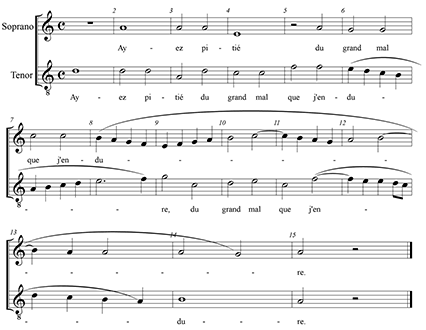
Both staves are played in treble clef, common time, and consist of fifteen measures. Soprano. Measure
one. Whole rest. Measure two. Whole note on A. Measure three. Two half notes, both on A. Measure four.
Whole note on E. Measure five. Half rest. Half note on A. Measure six. Two half notes, both on G.
Measure seven. Two half notes, both on C. Measure eight. Quarter note on B. Quarter note on A. Quarter
note on G. Quarter note on F. Measure nine. Quarter note on E. Quarter note on F. Quarter note on G.
Quarter note on A. Measure ten. Half note on B. Half note on C. Measure eleven. Quarter note on C. Tie
connecting the half note on C in measure ten to this quarter note. Quarter note on B. Quarter note on
A. Quarter note on G. Measure twelve. Half note on A. Half note on B.
Measure thirteen. Quarter note on B. Tie connecting the half note on B in measure twelve to this quarter
note. Quarter note on A. Half note on A. Measure fourteen. Half note on A. Half note on G. Long slur
connecting the quarter note on B in measure eight to the half note on G in this measure. Measure fifteen.
Half note on A. Half rest. Tenor. All notes should sound one octave lower than written.
Measure one. Whole note on D. Measure two. Two half notes, both on D. Measure three. Half note on A.
Half note on D. Measure four. Two half notes, both on C. Measure five. Two half notes, both on E. Measure
six. Quarter note on E. Quarter note on D. Quarter note on C. Quarter note on B.
Measure seven. Quarter note on A. Quarter note on B. Quarter note on C. Quarter note on D. Measure eight.
Dotted half note on E. Quarter note on F. Slur connecting the quarter note on E in measure six to the
quarter note on F in this measure. Measure nine. Half note on the D just below middle C. Half note on
C. Measure ten. Half note on D. Half note on E. Measure eleven. Half note on C. Half note on F. Measure
twelve. Quarter note on E. Tie connecting the half note on F in measure eleven to the quarter note on
F in this measure. Quarter note on E. Quarter note on E. Two beamed eighth notes, D and C.
Measure thirteen. Quarter note on D. Quarter note on C. Quarter note on B. Quarter note on A. Slur connecting
the half note on F in measure eleven to the quarter note on A in measure thirteen. Measure fourteen.
Whole note on B. Measure fifteen. Half note on A. Half rest.
Which of the following compositional devices common to vocal music is demonstrated in the excerpt?
- coloratura
- melisma
- arpeggio
- portamento
Answer to question 14
- Answer Enter to expand or collapse answer. Answer expanded
- Correct Response: B. (Objective 0010) A melisma is a term
usually applied to vocal music and refers to several notes being sung on a single syllable, normally
in one breath. The range of notes covered by the melisma is usually indicated by a slur connecting the
first and last notes. In the excerpt, there are three such examples in both the soprano part (measures
8–14) and the tenor part (measures 6–8 and 11–13).
Correct Response: B. (Objective 0010) A melisma is a term usually applied to vocal
music and refers to several notes being sung on a single syllable, normally in one breath. The range
of notes covered by the melisma is usually indicated by a slur connecting the first and last notes.
In the excerpt, there are three such examples in both the soprano part (measures 8 through 14) and the
tenor part (measures 6 through 8 and 11 through 13).
Question 15
15. Use the graphic below to answer the question that follows.

Which of the following pitches correctly completes the 12-tone row shown above?
- F-natural
- D-flat
- G-sharp
- B-flat
Answer to question 15
- Answer Enter to expand or collapse answer. Answer expanded
- Correct Response: D. (Objective 0010) In 12-tone serialism,
a tone row melody must present all 12 notes, or pitch classes, of the chromatic scale once before a
note can be repeated. The tone row assumes enharmonic equivalency, meaning that C-sharp equals D-flat,
E-sharp equals F-natural, etc. The only pitch class missing from the tone row above is B-flat.
Correct Response: D. (Objective 0010) In 12-tone serialism, a tone row melody must
present all 12 notes, or pitch classes, of the chromatic scale once before a note can be repeated. The
tone row assumes enharmonic equivalency, meaning that C-sharp equals D-flat, E-sharp equals F-natural,
etc. The only pitch class missing from the tone row above is B-flat.
Question 16
16. Which of the following elements is most characteristic of late-Baroque music?
- church modes
- clarinet instrumentation
- basso continuo
- thin textures
Answer to question 16
- Answer Enter to expand or collapse answer. Answer expanded
- Correct Response: C. (Objective 0011) A basso continuo is
typical of Baroque music and consists of a bass instrument, like cello or bassoon, and a keyboard instrument,
like organ or harpsichord. The basso continuo gives Baroque pieces their thick textures and functionally-tonal
harmonic structures. The harpsichord was used almost exclusively within the Baroque era. Thus, harpsichord
and basso continuo are essentially synonymous with Baroque music.
Correct Response: C. (Objective 0011) A basso continuo is typical of Baroque music
and consists of a bass instrument, like cello or bassoon, and a keyboard instrument, like organ or harpsichord.
The basso continuo gives Baroque pieces their thick textures and functionally-tonal harmonic structures.
The harpsichord was used almost exclusively within the Baroque era. Thus, harpsichord and basso continuo
are essentially synonymous with Baroque music.
Question 17
17. Which of the following European composers wrote the first successful opera?
- Arcangelo Corelli
- Claudio Monteverdi
- Jean-Baptiste Lully
- Henry Purcell
Answer to question 17
- Answer Enter to expand or collapse answer. Answer expanded
- Correct Response: B. (Objective 0011) According to many musicologists,
the first true European example of the genre known as opera was Monteverdi's L'Orfeo, first
performed in 1607. It is still the most frequently performed of all early operas and contains a libretto,
an instrumental overture, recitatives, arias, and choruses, all of which are important elements of the
genre.
Correct Response: B. (Objective 0011) According to many musicologists, the first
true European example of the genre known as opera was Monteverdi's start italics L'Orfeo end italics, first performed
in 1607. It is still the most frequently performed of all early operas and contains a libretto, an instrumental
overture, recitatives, arias, and choruses, all of which are important elements of the genre.
Question 18
18. The bowed string instruments known as viols that were popular during the Renaissance and Baroque
periods differed from the violin family in which of the following ways?
- Viols had curved fingerboards and four pairs of strings.
- Viols were generally larger and made a louder sound.
- Viols were used as ensemble rather than solo instruments.
- Viols had fretted fingerboards and six strings.
Answer to question 18
- Answer Enter to expand or collapse answer. Answer expanded
- Correct Response: D. (Objective 0011) Viols are bowed string
instruments that were developed in Europe during the late fifteenth century. They were built in many
different sizes, but treble, tenor, and bass were most common. These instruments were characterized
by fretted fingerboards and most commonly had six strings. They were often employed in ensembles, but
in France the bass viol was favored as a solo instrument. String instruments of the violin family, which
came into common use during the seventeenth century, have four strings and an unfretted fingerboard.
Correct Response: D. (Objective 0011) Viols are bowed string instruments that were
developed in Europe during the late fifteenth century. They were built in many different sizes, but
treble, tenor, and bass were most common. These instruments were characterized by fretted fingerboards
and most commonly had six strings. They were often employed in ensembles, but in France the bass viol
was favored as a solo instrument. String instruments of the violin family, which came into common use
during the seventeenth century, have four strings and an unfretted fingerboard.
Question 19
19. Which of the following statements best describes Johann Sebastian Bach's impact on the history of
Western music?
- Bach was the first composer to write four-part string and woodwind quartets.
- Bach's operas synthesize established traditions associated with Italian and French styles.
- Bach led the development of musical nationalism through tone poems and mazurkas.
- Bach's chorales are microcosms of functional tonality and textbook dissonance treatment.
Answer to question 19
- Answer Enter to expand or collapse answer. Answer expanded
- Correct Response: D. (Objective 0011) For centuries, musicians
have studied J.S. Bach's 371 chorales to better understand harmonic progressions, voice leading, and
ways of preparing and resolving dissonances. Of the genres listed above, the only one in which Bach
composed is chorale.
Correct Response: D. (Objective 0011) For centuries, musicians have studied J.S.
Bach's 371 chorales to better understand harmonic progressions, voice leading, and ways of preparing
and resolving dissonances. Of the genres listed above, the only one in which Bach composed is chorale.
Question 20
20. George Frideric Handel's start italics Giulio Cesare, Alcina end italics, and start italics Rodelinda end italics
all exemplify which of the following vocal genres?
- coronation anthem
- oratorio
- opera seria
- cantata
Answer to question 20
- Answer Enter to expand or collapse answer. Answer expanded
- Correct Response: C. (Objective 0011). George Frideric Handel
(1685–1759) wrote over three dozen operas. Giulio Cesare, Alcina, and Rodelinda
are all outstanding examples of the most prestigious type of opera in the eighteenth century Baroque,
opera seria.
Correct Response: C. (Objective 0011). George Frideric Handel (1685 to 1759) wrote
over three dozen operas. start italics Giulio Cesare, Alcina end italics, and start italics Rodelinda end italics are all outstanding
examples of the most prestigious type of opera in the eighteenth century Baroque, opera seria.
Question 21
21. Use the excerpt below to answer the question that follows.
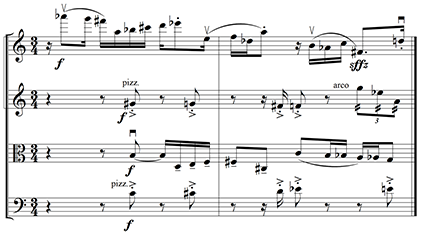
All staves consist of two measures. First staff. Treble clef. Three over four time signature. Sixteenth
rest. Following notes are to be played forte. Two beamed notes. First is an eighth note on the A flat
to be played marcato just above the fourth ledger line above the staff. Second is a sixteenth note on
the G just below the preceding A. Four beamed sixteenth notes. F just below the preceding G. Slur connecting
this note to the eighth note on the A flat to be played marcato just above the fourth ledger line above
the staff. A one ledger line above staff. B flat just above the preceding A. C sharp just above the
preceding B flat. Three beamed notes. First is a sixteenth note on the D just above the preceding C
sharp. Second is an eighth note to be played staccato on the E flat just above the preceding D. Third
is a sixteenth note to be played marcato on E. Measure two. Three beamed notes. Sixteenth note on F.
Sixteenth note on B flat. Eighth note to be played staccato on the A one ledger line above staff. Sixteenth
rest. Three beamed sixteenth notes. B to be played marcato, A flat, and C. Following notes are to be
played sforzato. Two beamed notes. Dotted eighth note on F sharp. Slur connecting this note to the sixteenth
note on B in this measure. Sixteenth note to be played staccato and down bow on D natural.
Second staff. Treble clef. Three over four time signature. Measure one. Quarter rest. Eighth rest. Following
notes to be played pizzicato and forte. Eighth note to be played staccato and accented on G sharp. Eighth
rest. Eighth note to be played staccato and accented on G natural. Measure two. Eighth rest. Sixteenth
rest. Sixteenth note to be played staccato and accented on F sharp. Eighth note to be played staccato
and accented on F natural. Eighth rest. Following notes to be played arco. Three beamed eighth notes,
all with two slashes through their stems. G just above the staff, E flat, and A. Number three just below
the beam connecting these notes.
Third staff. C clef. Three over four time signature. Measure one. Quarter rest. Eighth rest. Following
notes to be played forte. Eighth note to be played down bow on A. Four beamed sixteenth notes. A, middle
C to be played tenuto, the D just above middle C to be played tenuto, E to be played tenuto. Tie connecting
the sixteenth note on A to the eighth note on A. Measure two. Two beamed eighth notes. E sharp to be
played tenuto, and the B sharp just above middle C to be played tenuto. Three beamed notes. Eighth note
on B. Sixteenth note on A. Sixteenth note on A flat. Three beamed notes. Sixteenth note on G. Sixteenth
note on G flat. Eighth note on F. Slur connecting the eighth note on B to the sixteenth note on G.
Fourth staff. Bass clef. Three over four time signature. Measure one. Quarter rest. Eighth rest. Following
notes to be played pizzicato and forte. Eighth note to be played staccato and accented on middle C.
Eighth rest. Eighth note to be played staccato and accented on middle C sharp. Measure two. Eighth rest.
Sixteenth rest. Sixteenth note to be played staccato and accented on the D just above middle C. Eighth
note to be played staccato and accented on the E just above the preceding D. Eighth rest. Eighth rest.
Eighth note to be played staccato and accented on the E natural two ledger lines above staff.
The musical structure, stylistic characteristics, and specific expressive aspects indicated in the excerpt
suggest that it is most likely from which of the following works?
- a wind quartet by Pierre Boulez
- a brass quartet by Leonard Bernstein
- a pitched percussion quartet by Milton Babbitt
- a string quartet by Alban Berg
Answer to question 21
- Answer Enter to expand or collapse answer. Answer expanded
- Correct Response: D. (Objective 0012) The configuration of
the excerpt—two treble clef lines, one alto clef line, and one bass clef line—is the standard
arrangement for string quartet music, which typically includes two violins (treble clefs), viola (alto
clef), and cello (bass clef). The indication pizz. (pizzicato, to pluck a string) and arco
(to use the bow) in two of the parts, as well as occasional symbols for down-bow and up-bow, confirms
that this is a work for strings. Furthermore, the use of accidentals rather than a key signature to
define pitches and the dissonant harmonic style are characteristics consistent with those that might
be found in a twentieth-century atonal work—one that would be typical of Austrian composer Alban
Berg, who was the student of Arnold Schoenberg.
Correct Response: D. (Objective 0012) The configuration of the excerpt—two
treble clef lines, one alto clef line, and one bass clef line—is the standard arrangement for
string quartet music, which typically includes two violins (treble clefs), viola (alto clef), and cello
(bass clef). The indication start italics pizz end italics. (pizzicato, to pluck a string) and arco (to use
the bow) in two of the parts, as well as occasional symbols for down-bow and up-bow, confirms that this
is a work for strings. Furthermore, the use of accidentals rather than a key signature to define pitches
and the dissonant harmonic style are characteristics consistent with those that might be found in a
twentieth-century atonal work—one that would be typical of Austrian composer Alban Berg, who was
the student of Arnold Schoenberg.
Question 22
22. start italics Black, Brown and Beige end italics is a twentieth-century work that fits which of the following descriptions?
- an opera by George Gershwin
- a concerto by William Grant Still
- a jazz symphony by Duke Ellington
- a ragtime suite by Scott Joplin
Answer to question 22
- Answer Enter to expand or collapse answer. Answer expanded
- Correct Response: C. (Objective 0012) Duke Ellington was
a pioneering U.S. composer, pianist, and bandleader from the 1920s to the 1970s. He composed not only
songs and many extended compositions for his famous band, but also works for the stage and for film.
He experimented with longer forms that incorporated elements of both classical and jazz styles, and
in 1943 he premiered at Carnegie Hall a 45-minute, three-movement concert work titled Black, Brown
and Beige. Because its length, thematic treatments, and structure resemble a classical symphonic
model, the work has been referred to as a symphony.
Correct Response: C. (Objective 0012) Duke Ellington was a pioneering U.S. composer,
pianist, and bandleader from the 1920s to the 1970s. He composed not only songs and many extended compositions
for his famous band, but also works for the stage and for film. He experimented with longer forms that
incorporated elements of both classical and jazz styles, and in 1943 he premiered at Carnegie Hall a
45-minute, three-movement concert work titled start italics Black, Brown and Beige end italics. Because its length, thematic
treatments, and structure resemble a classical symphonic model, the work has been referred to as a symphony.
Question 23
23. A virtuoso harp and a treble chorus are the performing forces used in which of the following significant
twentieth-century choral works in which ancient texts were given unique, contemporary settings?
- start italics The Peaceable Kingdom end italics by Randall Thompson
- start italics Chester Psalms end italics by Leonard Bernstein
- start italics Mass of the Children end italics by John Rutter
- start italics A Ceremony of Carols end italics by Benjamin Britten
Answer to question 23
- Answer Enter to expand or collapse answer. Answer expanded
- Correct Response: D. (Objective 0012) In 1942, English composer
Benjamin Britten was returning to Britain by ship from the United States when, during a stop in Halifax,
Nova Scotia, he purchased a book of medieval poems. During the weeks-long voyage, he was inspired to
set several of the poems to music, for the unusual combination of treble voices and harp. He chose texts
related to the story of Christmas, and in the musical settings ingeniously combined modal and modern
harmonic and melodic structures to give the music both a medieval and a modern character. After completing
the first group of seven songs, Britten later made some revisions and additions (including a harp solo)
and organized the set into a concert work, which he titled A Ceremony of Carols.
Correct Response: D. (Objective 0012) In 1942, English composer Benjamin Britten
was returning to Britain by ship from the United States when, during a stop in Halifax, Nova Scotia,
he purchased a book of medieval poems. During the weeks-long voyage, he was inspired to set several
of the poems to music, for the unusual combination of treble voices and harp. He chose texts related
to the story of Christmas, and in the musical settings ingeniously combined modal and modern harmonic
and melodic structures to give the music both a medieval and a modern character. After completing the
first group of seven songs, Britten later made some revisions and additions (including a harp solo)
and organized the set into a concert work, which he titled start italics A Ceremony of Carols end italics.
Question 24
24. Which of the following trio of composers best exemplifies the style holy minimalism?
- Henryk Górecki, Arvo Pärt, John Tavener
- John Adams, Steve Reich, Terry Riley
- Claude Debussy, Maurice Ravel, Erik Satie
- Alban Berg, Arnold Schoenberg, Anton Webern
Answer to question 24
- Answer Enter to expand or collapse answer. Answer expanded
- Correct Response: A. (Objective 0012) The term holy minimalism
describes a late twentieth- and early twenty-first-century musical style in which primarily European
composers set sacred (holy) texts using limited musical materials and ample repetition (minimalism).
Although the other trios of composers all share a particular style, the only composers above who all
wrote holy minimalism are the Polish Henryk Górecki (1933–2010), Estonian Arvo Pärt
(1935–), and British John Tavener (1944–2013).
Correct Response: A. (Objective 0012) The term start italics holy minimalism end italics describes
a late twentieth- and early twenty-first-century musical style in which primarily European composers
set sacred (holy) texts using limited musical materials and ample repetition (minimalism). Although
the other trios of composers all share a particular style, the only composers above who all wrote holy
minimalism are the Polish Henryk Górecki (1933 to 2010), Estonian Arvo Pärt (1935 dash),
and British John Tavener (1944 to 2013).
Question 25
25. Which of the following accomplishments best describes Franz Schubert's role in Western music history?
- inventing the string quartet genre
- reviving an interest in J.S. Bach's vocal music
- popularizing Polish folk dances
- contributing to the development of the lied
Answer to question 25
- Answer Enter to expand or collapse answer. Answer expanded
- Correct Response: D. (Objective 0012) The six hundred art
songs, or lieder, by Franz Schubert (1797–1828) contain remarkable chromatic innovations and exemplary
musical expressions of the text. While the other options describe the musical contributions of Franz
Joseph Haydn, Felix Mendelssohn, and Frédéric Chopin, respectively, Schubert is best remembered
for developing the German lied.
Correct Response: D. (Objective 0012) The six hundred art songs, or lieder, by
Franz Schubert (1797 to 1828) contain remarkable chromatic innovations and exemplary musical expressions
of the text. While the other options describe the musical contributions of Franz Joseph Haydn, Felix
Mendelssohn, and Frédéric Chopin, respectively, Schubert is best remembered for developing
the German lied.
Question 26
26. start italics El Salón México, Billy the Kid end italics, and start italics Lincoln Portrait end italics were
all written by which of the following composers?
- Charles Ives
- George Gershwin
- Aaron Copland
- Leonard Bernstein
Answer to question 26
- Answer Enter to expand or collapse answer. Answer expanded
- Correct Response: C. (Objective 0013) Aaron Copland (1900–1990)
is known for a relatively accessible diatonic-oriented compositional language as compared to his avant-garde
contemporaries like Charles Ives. Copland's best known works include El Salón México
(1936), Billy the Kid (1938), and Lincoln Portrait (1942). They all contain elements
typical of Copland's style, including the use of folk songs and rhythms, cowboy tunes, and Americana
themes, respectively.
Correct Response: C. (Objective 0013) Aaron Copland (1900 to 1990) is known for
a relatively accessible diatonic-oriented compositional language as compared to his avant-garde contemporaries
like Charles Ives. Copland's best known works include start italics El Salón México end italics
(1936), start italics Billy the Kid end italics (1938), and start italics Lincoln Portrait end italics (1942). They all contain elements
typical of Copland's style, including the use of folk songs and rhythms, cowboy tunes, and Americana
themes, respectively.
Question 27
27. The formal instrumental ensemble known as the gamelan and the folk instrument known as the angklung
are associated with which of the following countries?
- China
- India
- Indonesia
- Vietnam
Answer to question 27
- Answer Enter to expand or collapse answer. Answer expanded
- Correct Response: C. (Objective 0013) Gamelan is
an Indonesian word meaning "musical ensemble." This type of ensemble, which often consists of bronze
metallophones of various shapes and sizes, xylophones, membranophones, an aerophone, and sometimes a
chordophone, is one of the larger instrumental ensembles originating outside the Western world. The
gamelan is common in Java, the most heavily populated island in Indonesia. It is also important in the
history of classical music in Bali, and certainly other islands of this large country. The angklung
is a bamboo folk instrument originally discovered in the villages of Bali and today is known throughout
the country of Indonesia. It was commonly associated with village festivals.
Correct Response: C. (Objective 0013) start italics Gamelan end italics is an Indonesian word meaning
"musical ensemble." This type of ensemble, which often consists of bronze metallophones of various shapes
and sizes, xylophones, membranophones, an aerophone, and sometimes a chordophone, is one of the larger
instrumental ensembles originating outside the Western world. The gamelan is common in Java, the most
heavily populated island in Indonesia. It is also important in the history of classical music in Bali,
and certainly other islands of this large country. The angklung is a bamboo folk instrument originally
discovered in the villages of Bali and today is known throughout the country of Indonesia. It was commonly
associated with village festivals.
Question 28
28. In addition to Native American music, which of the following musical genres is widely recognized
as the first authentic folk music created in the United States?
- blues
- gospel
- ragtime
- spirituals
Answer to question 28
- Answer Enter to expand or collapse answer. Answer expanded
- Correct Response: D. (Objective 0013) Spirituals are religious
folk songs that were created and first sung by African Americans in slavery. Most scholars speculate
that these songs first appeared in the late 1700s and remained common through the end of legalized slavery
in the 1860s. By borrowing from Protestant hymns, reworking them, and then making up new melodies and
harmonies, African Americans developed the first authentic religious folk music in the United States.
Often hidden in these songs was a secret code designed to send messages of hope and freedom to the slave
community.
Correct Response: D. (Objective 0013) Spirituals are religious folk songs that
were created and first sung by African Americans in slavery. Most scholars speculate that these songs
first appeared in the late 1700s and remained common through the end of legalized slavery in the 1860s.
By borrowing from Protestant hymns, reworking them, and then making up new melodies and harmonies, African
Americans developed the first authentic religious folk music in the United States. Often hidden in these
songs was a secret code designed to send messages of hope and freedom to the slave community.
Question 29
29. Which of the following terms best describes the musical characteristic in sub-Saharan Africa of
adding new parts to music as it is being performed?
- interlocking
- cyclical form
- call and response
- ostinato
Answer to question 29
- Answer Enter to expand or collapse answer. Answer expanded
- Correct Response: A. (Objective 0013) A basic musical value
in many sub-Saharan African societies is the ability to add one's own distinctive part to the ensemble
while making it blend with the whole. Drum patterns, hand-clapping patterns, dance movements, and vocal
melodies performed by participants frequently do not simply reproduce the basic beat and are typically
not performed in unison. Rather, each participant may add his or her own rhythmic patterns, vocal parts,
or dance movements so that they fall between or around central beats and pitches, in the spaces of other
participants' parts. This performance practice is known as interlocking.
Correct Response: A. (Objective 0013) A basic musical value in many sub-Saharan
African societies is the ability to add one's own distinctive part to the ensemble while making it blend
with the whole. Drum patterns, hand-clapping patterns, dance movements, and vocal melodies performed
by participants frequently do not simply reproduce the basic beat and are typically not performed in
unison. Rather, each participant may add his or her own rhythmic patterns, vocal parts, or dance movements
so that they fall between or around central beats and pitches, in the spaces of other participants'
parts. This performance practice is known as interlocking.
Question 30
30. Ella Fitzgerald and Billie Holiday most strongly cultivated which of the following musical styles?
- rock
- opera
- jazz
- folk
Answer to question 30
- Answer Enter to expand or collapse answer. Answer expanded
- Correct Response: C. (Objective 0013) Ella Fitzgerald (1917–1996)
and Billie Holiday (1915–1959) both sang jazz but developed it in different ways. For example,
Ella Fitzgerald is best remembered for a type of jazz singing called scat while Billie Holiday's expressive
recordings of jazz standards reflect her troubled life.
Correct Response: C. (Objective 0013) Ella Fitzgerald (1917 to 1996) and Billie
Holiday (1915 to 1959) both sang jazz but developed it in different ways. For example, Ella Fitzgerald
is best remembered for a type of jazz singing called scat while Billie Holiday's expressive recordings
of jazz standards reflect her troubled life.
Question 31
31. Use the excerpt below from start italics Gartenlieder end italics by Fanny Hensel to answer the question that follows.
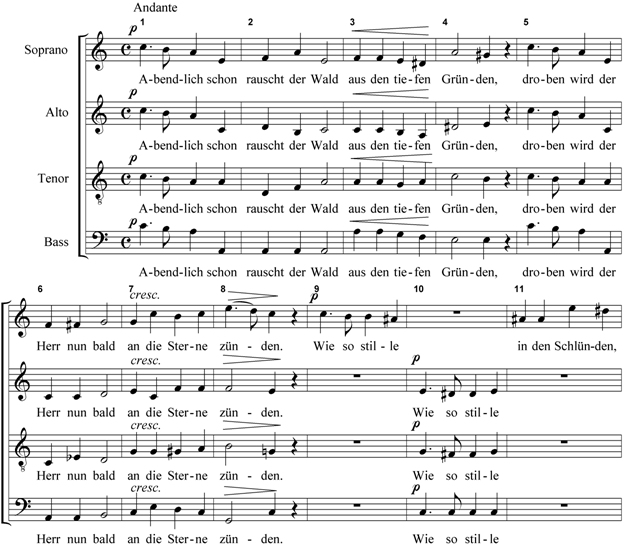
The texture of the excerpt is primarily homorhythmic homophonic. The text is as follows. Abendlich schon
rauscht der Wald aus den tiefen Gründen, droben wird der Herr nun bald an die Sterne zünden.
Wie so stille in den Schlünden. The piece begins piano and has crescendos in measures 3 and 7,
which drives to a decrescendo in measure 8. In measure 9 it returns to a piano dynamic.
Which of the following words in this excerpt should receive the heaviest articulation?
- start italics Abendlich end italics in measure 1
- start italics der end italics in measure 5
- start italics zünden end italics in measure 8
- start italics Wie end italics in measure 10
Answer to question 31
- Answer Enter to expand or collapse answer. Answer expanded
- Correct Response: C. (Objective 14) In this excerpt, the
word zünden coincides with the loudest and highest note of the composition and is the
last word of the sentence toward which all other words are driving. In phonetic terms, the German letter
z is a voiceless alveolar affricative that requires an explosive sound produced by the tip of the tongue
similar to the sound at the end of the English word cats.
Correct Response: C. (Objective 14) In this excerpt, the word start italics zünden end italics
coincides with the loudest and highest note of the composition and is the last word of the sentence
toward which all other words are driving. In phonetic terms, the German letter z is a voiceless alveolar
affricative that requires an explosive sound produced by the tip of the tongue similar to the sound
at the end of the English word cats.
Question 32
32. Which of the following seating arrangements would be most effective for a high school choir in which
the sopranos and altos outnumber the tenors and basses and the basses outnumber the tenors?
-
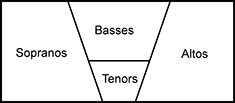
The remaining space in the middle resembles a trapezoid with the top
part pointing downward. Basses are seated in the top-third of the trapezoid; tenors are seated in the
bottom third.
-
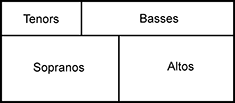
Largest sections are sopranos and altos, occupying the bottom-left and
bottom-right corners of the room, respectively, and both sections
meet in the middle space. Basses occupy the top-right corner, extending into the top-left corner. The
small space remaining in the top-left corner belongs to the tenors.
-
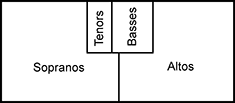
Basses occupy a much smaller rectangular space that encroaches on the
top-left part of the altos section. Adjacent to the basses (encroaching in top-right of soprano territory)
are the tenors, who occupy a comparatively smaller rectangular space.
-
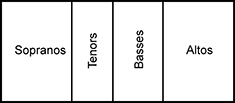
Basses are seated to the left of altos in an area roughly half their
size. Tenors are seated to the left of the basses (and, therefore, to the right of sopranos) in an area
roughly half the size of basses.
Answer to question 32
- Answer Enter to expand or collapse answer. Answer expanded
- Correct Response: A. (Objective 0014) The best seating arrangement
for this scenario is to put the tenors and basses in the center of the choir with the weaker of the
two sections (tenors) as far forward as possible. This will solidify the lower sections and help balance
the sound. The lower sections will be surrounded by the two higher sections and will be able to hear
both equally well, and the tenors, who will have the support of all three sections around and behind
them, will project better to the audience at the same time.
Correct Response: A. (Objective 0014) The best seating arrangement for this scenario
is to put the tenors and basses in the center of the choir with the weaker of the two sections (tenors)
as far forward as possible. This will solidify the lower sections and help balance the sound. The lower
sections will be surrounded by the two higher sections and will be able to hear both equally well, and
the tenors, who will have the support of all three sections around and behind them, will project better
to the audience at the same time.
Question 33
33. A vocal music teacher is selecting literature for an experienced high school choir. Which of the
following vocal ranges would be most appropriate for the teacher to consider as a comfortable tessitura
for the altos?
-

-

-

-

Answer to question 33
- Answer Enter to expand or collapse answer. Answer expanded
- Correct Response: B. (Objective 0014) When selecting appropriate
literature for a high school choir, the teacher should make sure the range of each vocal line is within
the capabilities of the students who will be singing it. Even more importantly, the tessitura, or the
range in which most of the notes in a given part lie, should be comfortable for the singers. High school
singers can handle an occasional note in the extreme of their range, but it can be very tiring if the
line lies consistently in the high part of their singable range. The correct range for altos is usually
from the G below the staff in the treble clef to the E in the top space of the staff. However, the tessitura
is usually from the B below the staff to the C in the third space.
Correct Response: B. (Objective 0014) When selecting appropriate literature for
a high school choir, the teacher should make sure the range of each vocal line is within the capabilities
of the students who will be singing it. Even more importantly, the tessitura, or the range in which
most of the notes in a given part lie, should be comfortable for the singers. High school singers can
handle an occasional note in the extreme of their range, but it can be very tiring if the line lies
consistently in the high part of their singable range. The correct range for altos is usually from the
G below the staff in the treble clef to the E in the top space of the staff. However, the tessitura
is usually from the B below the staff to the C in the third space.
Question 34
34. A vocal music teacher asks a singer to place a tone forward. The singer's most appropriate response
would be to:
- keep the throat open and relaxed.
- maximize the resonance created by the soft palate.
- use diaphragmatic costal breathing.
- maximize the resonance created by the hard palate.
Answer to question 34
- Answer Enter to expand or collapse answer. Answer expanded
- Correct Response: D. (Objective 0014) The roof of the mouth
begins immediately behind the teeth with the hard palate and becomes the soft palate farther back in
the mouth and throat. Placing the tone forward is making sure that the resonance comes from the hard
palate as much as possible.
Correct Response: D. (Objective 0014) The roof of the mouth begins immediately
behind the teeth with the hard palate and becomes the soft palate farther back in the mouth and throat.
Placing the tone forward is making sure that the resonance comes from the hard palate as much as possible.
Question 35
35. Use the graphic below to answer the question that follows.

This vocal warm-up activity should most strongly improve which of the following aspects of vocal production?
- air support
- vowel uniformity
- proper posture
- dynamic contrast
Answer to question 35
- Answer Enter to expand or collapse answer. Answer expanded
- Correct Response: B. (Objective 0014) The vocal warm-up shown
above contains five different vowels arranged from brightest to darkest. Moreover, these vowels are
the five pure Latin vowel sounds that are combined in a diphthong. For example, the one-syllable word
"fire" is a diphthong consisting of two distinct vowel sounds: fah and ir. Singers
should aim to produce uniform vowels by prolonging the first pure vowel of a diphthong. The warm-up
shown above can help singers achieve such vowel purity and uniformity.
Correct Response: B. (Objective 0014) The vocal warm-up shown above contains five
different vowels arranged from brightest to darkest. Moreover, these vowels are the five pure Latin
vowel sounds that are combined in a diphthong. For example, the one-syllable word "fire" is a diphthong
consisting of two distinct vowel sounds: start italics fah end italics and start italics ir end italics. Singers should aim to produce
uniform vowels by prolonging the first pure vowel of a diphthong. The warm-up shown above can help singers
achieve such vowel purity and uniformity.
Question 36
36. Use the excerpt below to answer the question that follows.
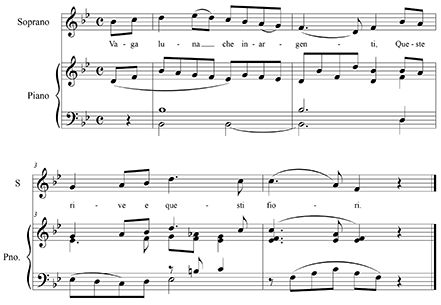
Both staves consist of four measures, and are to be played in the key of B flat, common time. Soprano.
Measure one. Two beamed eighth notes, B and C. Measure two. Quarter note on D. Two beamed eighth notes,
E and D, with a slur connecting them. Four beamed eighth notes. C, B, A, and G, with a slur connecting
the last two notes. Measure three. Dotted quarter note on F. Eighth note on the D just above middle
C. A slur connects these two notes. Quarter note on F. Two beamed eighth notes, B and A. Quarter note
on G. Two beamed eighth notes, A and B. Dotted quarter note on D. Eighth note on C. Measure four. Dotted
quarter note on C. Eighth note on A. A slur connects these two notes. Quarter note on F. Quarter rest.
Piano. Measure one. Treble clef. Two beamed eighth notes, D just above middle C, and F. Bass clef. Quarter
rest. Measure two. Treble clef. Four beamed eighth notes. B, A, G, and F. Four more beamed eighth notes.
E, G, F, and E. A tie connects the first E in this set of beamed eighth notes to the eighth note on
D just above middle C in measure one. Bass clef. Two notes to be played simultaneously, half note on
B and whole note on the B just below middle C. Half note on B. Measure three. Treble clef. Four beamed
eighth notes. D just above middle C, B, F, and D. Two quarter notes to be played simultaneously, D just
above middle C and B. Two beamed eighth notes, B and A. An F is played simultaneously with the eighth
note on B. Quarter note on G. Two eighth notes, A and B. Dotted quarter note on F. Eighth note on C.
Bass clef. Two half notes played simultaneously, B and B just below middle C. A tie connects the B in
this measure to the B in measure two. Quarter note on D with stems pointing upward and downward. Four
beamed eighth notes. E, D, C, and D. Slur connecting the eighth note on E to the eighth note on C. Half
note on E with an eighth rest on top. Eighth note on B natural just below middle C. Quarter note on
middle C. Measure four. Treble clef. Three dotted quarter notes played simultaneously. E, F, and C.
Two eighth notes played simultaneously, E and A. Two quarter notes played simultaneously, E and F. Quarter
rest. Bass clef. Eighth rest. Three beamed eighth notes. F, A, and middle C. Two beamed eighth notes,
A and F. Quarter rest.
A high school–age baritone singer wishes to perform the song represented in the excerpt
and shows the score to his vocal music teacher. The teacher evaluates the music to determine whether
the song is suitable for the student's voice and to decide whether any changes should be made for him
to perform it successfully. Which of the following would be the teacher's most appropriate conclusion?
- The student should sing the song in its current range, using falsetto where necessary.
- The song should be transposed down a major second.
- The song should be transposed down an octave.
- The student should sing the song in its current range, but in an English translation.
Answer to question 36
- Answer Enter to expand or collapse answer. Answer expanded
- Correct Response: C. (Objective 0015) The music teacher's
task is to determine whether the song's melody lies in an appropriate range for the high school baritone
singer, and, if it does not, to know what adjustment to make for him to properly perform the song. Generally,
a high school–age baritone has a comfortable singing range from the A in the second octave below
middle C to the D above middle C. The melody written in the excerpt, which perfectly suits the comfortable
range for a soprano, lies too high for a baritone. A simple transposition of the melody down an octave
will place it easily within the baritone's range. Although the E flat, the highest note in the melody,
may be slightly outside the baritone's most comfortable singing range, this is a singable pitch for
most baritones. Its short duration and position in the rising melody in this excerpt makes it easy to
sing without straining the voice.
Correct Response: C. (Objective 0015) The music teacher's task is to determine
whether the song's melody lies in an appropriate range for the high school baritone singer, and, if
it does not, to know what adjustment to make for him to properly perform the song. Generally, a high
school–age baritone has a comfortable singing range from the A in the second octave below middle
C to the D above middle C. The melody written in the excerpt, which perfectly suits the comfortable
range for a soprano, lies too high for a baritone. A simple transposition of the melody down an octave
will place it easily within the baritone's range. Although the E flat, the highest note in the melody,
may be slightly outside the baritone's most comfortable singing range, this is a singable pitch for
most baritones. Its short duration and position in the rising melody in this excerpt makes it easy to
sing without straining the voice.
Question 37
37. Use the excerpt below to answer the question that follows.
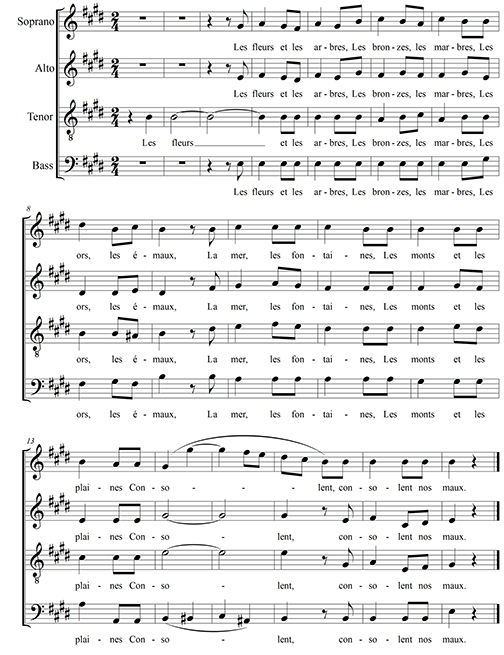
All staves are played in the key of E major with a two over four time signature, and consist of eighteen
measures. Staff one. Soprano. Treble clef. Measure one. Half rest. Measure two. Half rest. Measure three.
Quarter rest. Eighth rest. Eighth note on G. Measure four. Quarter note on A. Two beamed eighth notes,
G and F. Measure five. Quarter note on A. Two beamed eighth notes, G and B. Measure six. Quarter note
on C. Two beamed eighth notes, B and A. Measure seven. Quarter note on C. Two beamed eighth notes, both
on B. Measure eight. Quarter note on D. Two beamed eighth notes, B and C. Measure nine. Quarter note
on B. Eighth rest. Eighth note on B. Measure ten. Quarter note on C. Two beamed eighth notes, both on
C. Measure eleven. Quarter note on C. Two beamed eighth notes, both on B. Measure twelve. Quarter note
on B. Two beamed eighth notes, both on B. Measure thirteen. Quarter note on B. Two eighth notes, both
on A. Measure fourteen. Quarter note on G. Quarter note on the G just above staff. Measure fifteen.
Quarter note on the G just above staff. Tie connects this note to the preceding one. Two beamed eighth
notes, F and E. Measure sixteen. Two beamed eighth notes, D and C. Two more beamed eighth notes, both
on B. The first B is connected to the quarter note on G in measure fourteen with a slur. Measure seventeen.
Quarter note on B. Two beamed eighth notes, both on B. Measure eighteen. Quarter note on B. Measure
eighteen. Quarter note on B. Quarter rest.
Staff two. Alto. Treble clef. Measure one. Half rest. Measure two. Half rest. Measure three. Quarter
rest. Eighth rest. Eighth note on E. Measure four. Quarter note on F. Two beamed eighth notes, E and
the D just above middle C. Measure five. Quarter note on F. Two beamed eighth notes, E and G. Measure
six. Quarter note on F. Two beamed eighth notes, G and F. Measure seven. Quarter note on F. Two beamed
eighth notes, G and E. Measure eight. Quarter note on D just above middle C. Two eighth notes, one on
D just above middle C and E. Measure nine. Quarter note on D just above middle C. Eighth rest. Eighth
note on F. Measure ten. Quarter note on G. Two beamed eighth notes, A and G. Measure eleven. Quarter
note on F. Two beamed eighth notes, both on F. Measure twelve. Quarter note on F. Two beamed eighth
notes, G and F. Measure thirteen. Quarter note on E. Two beamed eighth notes, both on E. Measure fourteen.
Half note on G. Measure fifteen. Half note on G. This half note is connected to the preceding half note
with a tie. Measure sixteen. Quarter note on G. Eighth rest. Eighth note on E. Measure seventeen. Quarter
note on F. Two beamed eighth notes, middle C and the D just above middle C. Measure eighteen. Quarter
note on E. Quarter rest.
Staff three. Tenor. Treble clef. Notes in this staff should sound one octave lower than written. Measure
one. Quarter rest. Quarter note on B. Measure two. half note on B. Measure three. Half note on B. This
half note is connected to the preceding half note by a tie. Measure four. Quarter note on B. This note
is connected to the preceding half note on B in the previous measure. Two beamed eighth notes, both
on B. Measure five. Quarter note on B. Two beamed eighth notes, both on B. Measure six. Quarter note
on A. Two beamed eighth notes, B and C. Measure seven. Quarter note on A. Two beamed eighth notes, both
on B. Measure eight. Quarter note on B. Two beamed eighth notes, B and A sharp. Measure nine. Quarter
note on B. Eighth rest. Eighth note on D. Measure ten. Quarter note on E. Two beamed eighth notes, F
and E. Measure eleven. Quarter note on D. Two beamed eighth notes, both on D. Measure twelve. Quarter
note on D. Two beamed eighth notes, E and D. Measure thirteen. Quarter note on C. Two beamed eighth
notes, both on C. Measure fourteen. Half note on E. Measure fifteen. Half note on E. This half note
is connected to the half note in the previous measure by a tie. Measure sixteen. Quarter note on E.
Eighth rest. Eighth note on G. Measure seventeen. Quarter note on A. Two beamed eighth notes, E and
F. Measure eighteen. Quarter note on G. Half rest.
Staff four. Bass. Bass clef. Measure one. Half rest. Measure two. Half rest. Measure three. Quarter
rest. Eighth rest. Eighth note on E. Measure four. Quarter note on E. Two beamed eighth notes, both
on E. Measure five. Quarter note on E. Two beamed eighth notes, both on E. Measure six. Quarter note
on E. Two beamed eighth notes, both on E. Measure seven. Quarter note on E. Two beamed eighth notes,
E and G. Measure eight. Quarter note on F. Two beamed eighth notes, G and F. Measure nine. Quarter note
on the B just below middle C. Eighth rest. Eighth note on the B just below middle C. Measure ten. Quarter
note on A. Two beamed eighth notes, both on A. Measure eleven. Quarter note on A. Two beamed eighth
notes, both on A. Measure twelve. Quarter note on G. Two beamed eighth notes, both on G. Measure thirteen.
Quarter note on A. Two beamed eighth notes, both on A. Measure fourteen. Quarter note on B. Quarter
note on B sharp. Measure fifteen. Quarter note on C. Quarter note on A sharp. A slur connects this letter
to the quarter note on B in the previous measure. Measure sixteen. Quarter note on B. Eighth rest. Eighth
note on B. Measure seventeen. Quarter note on B. Two beamed eighth notes, both on B. Measure eighteen.
Quarter note on E. Quarter rest.
Which of the following would be the clearest, most effective way to conduct the music in the excerpt?
- in one with occasional subdivisions
- in strict one throughout
- in two with occasional subdivisions
- in strict two throughout
Answer to question 37
- Answer Enter to expand or collapse answer. Answer expanded
- Correct Response: A. (Objective 0015) The duple meter in
the excerpt might suggest conducting the music in two. However, the Allegretto moderato tempo
marking clearly indicates a faster tempo that would make conducting two beats to the bar impractical
and distracting. Another clue to the appropriate choice of conducting gesture is the designation of
the half note as the unit of beat (72 beats per minute), which means conducting each 2/4 measure in
one. Because of the nature of the phrasing, which often requires voices to enter together on a pickup
eighth note following a rest, it is likely that in these instances some singers' entrances may be early
or late. The conductor can ensure unified ensemble entrances by using a quick subdivided beat at these
points.
Correct Response: A. (Objective 0015) The duple meter in the excerpt might suggest
conducting the music in two. However, the start italics Allegretto moderato end italics tempo marking clearly indicates
a faster tempo that would make conducting two beats to the bar impractical and distracting. Another
clue to the appropriate choice of conducting gesture is the designation of the half note as the unit
of beat (72 beats per minute), which means conducting each 2/4 measure in one. Because of the nature
of the phrasing, which often requires voices to enter together on a pickup eighth note following a rest,
it is likely that in these instances some singers' entrances may be early or late. The conductor can
ensure unified ensemble entrances by using a quick subdivided beat at these points.
Question 38
38. Which of the following voice parts is most commonly given to the B-flat clarinet in a traditional
woodwind quartet?
- soprano
- alto
- tenor
- bass
Answer to question 38
- Answer Enter to expand or collapse answer. Answer expanded
- Correct Response: C. (Objective 0015) A traditional woodwind
quartet consists of a flute, oboe, B-flat clarinet, and bassoon. The tenor part is usually given to
the B-flat clarinet, while the soprano part is most often reserved for the flute, the alto part is assigned
to the oboe, and the bass part is given to the bassoon.
Correct Response: C. (Objective 0015) A traditional woodwind quartet consists of
a flute, oboe, B-flat clarinet, and bassoon. The tenor part is usually given to the B-flat clarinet,
while the soprano part is most often reserved for the flute, the alto part is assigned to the oboe,
and the bass part is given to the bassoon.
Question 39
39. A choral music director has chosen a secular choral piece from the Renaissance for a high school
chamber choir. The director wants to select a version of the score that will ensure the choir's performance
of the work is as close to authentic as possible. Which of the following questions would be most important
for the director to consider in evaluating various versions of the score?
- Is there a recording of the work included with the score to guide the conductor in making a correct
interpretation?
- Does the score clearly indicate which markings are from the composer and which have been added editorially?
- Have bar lines been added and the metrical scheme adjusted to fit modern notation for the convenience
of the performers?
- Does the score include numerous added expressive and dynamic markings to help with the interpretation
of this work?
Answer to question 39
- Answer Enter to expand or collapse answer. Answer expanded
- Correct Response: B. (Objective 0015) The original scores
of Renaissance music contain less information than those from later periods in Western music history.
Many musical decisions were routinely left to the performers. Markings that are present in the score
may be written in notation that is unintelligible to contemporary singers. A well-edited score will
clearly indicate which markings are from the composer and which have been added editorially, and often
notes concerning the piece, the composer, and the style are included.
Correct Response: B. (Objective 0015) The original scores of Renaissance music
contain less information than those from later periods in Western music history. Many musical decisions
were routinely left to the performers. Markings that are present in the score may be written in notation
that is unintelligible to contemporary singers. A well-edited score will clearly indicate which markings
are from the composer and which have been added editorially, and often notes concerning the piece, the
composer, and the style are included.
Question 40
40. A fifth-grade choir director is rehearsing the following song.
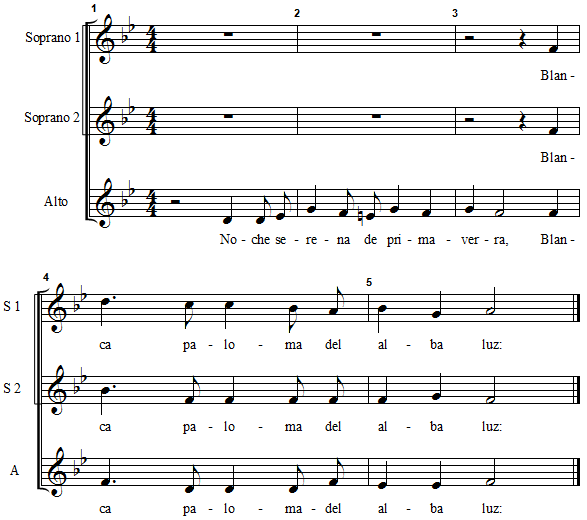
During the rehearsal, the teacher discovers that one of the students is learning to play trumpet in
the school band and would like the trumpet player to reinforce the alto line. Which of the following
arrangements from the teacher is most appropriate?
-

-

-

-

Answer to question 40
- Answer Enter to expand or collapse answer. Answer expanded
- Correct Response: C. (Objective 0015) The B-flat trumpet
produces a sound that is a major second below he written note. For example, whenever someone
plays a written C, the sound that comes out of that instrument is the name of the instrument. Thus,
whenever someone plays a written C on an instrument called a "B-flat trumpet," the sounding pitch is
the name of the instrument, B-flat. Since the trumpet sounds a major second below the written pitch,
the music must be written a major second higher than the desired sounding pitch.
Correct Response: C. (Objective 0015) The B-flat trumpet produces a sound that
is a major second start italics below end italics the written note. For example, whenever someone plays a written C, the
sound that comes out of that instrument is the name of the instrument. Thus, whenever someone plays
a written C on an instrument called a "B-flat trumpet," the sounding pitch is the name of the instrument,
B-flat. Since the trumpet sounds a major second below the written pitch, the music must be written a
major second higher than the desired sounding pitch.